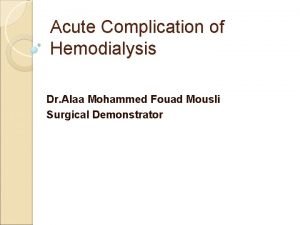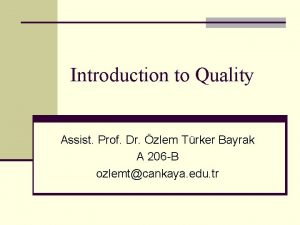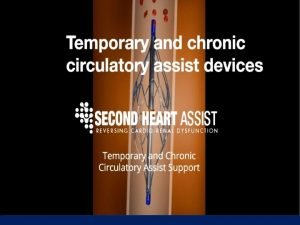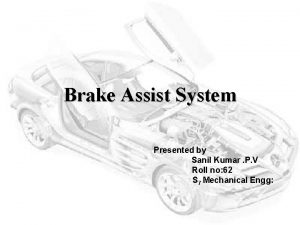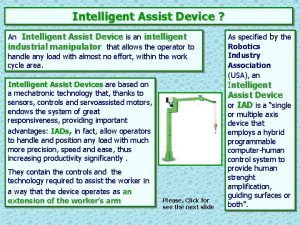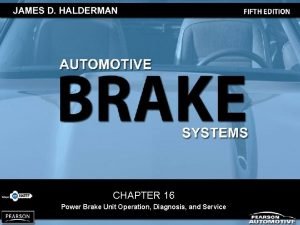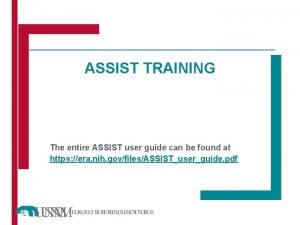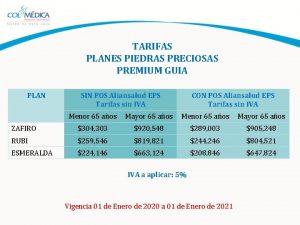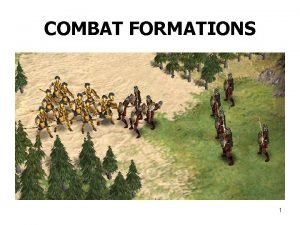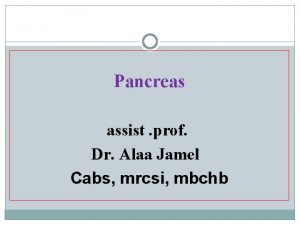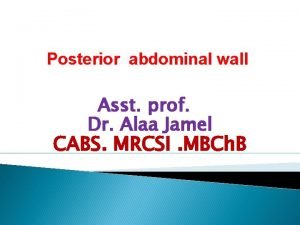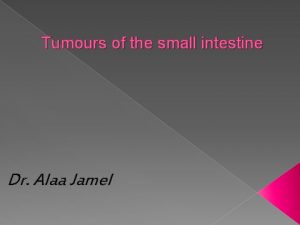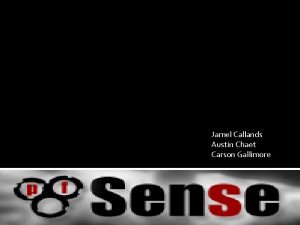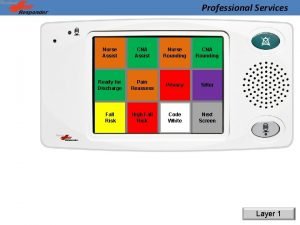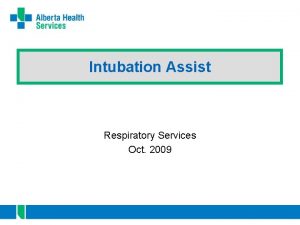Types of incisions assist prof dr Alaa Jamel























- Slides: 23

Types of incisions assist. prof. dr. Alaa Jamel MRCSI. CABS

1 -allow easy and rapid access to the relevant structures. 2 - allow easy extension 3 - should favors secure healing for the short – term (dehiscence ) and long term (herniation) 4 - should be relatively pain free post operatively. 5 -should have a satisfactory cosmotic appearance.

Types of incisions; 1. Midline incision; Through the lina alba , this provides good access, can be extended easily and is quick. It is relatively a vascular. Is more painful than transverse incisions. Crosses langer's lines. Poor cosmetic appearance. Narrow linea alba below umbilicus damag Some vessels cross the midline. May cause bladder injury.


b umbilical incision; used for repair of par umbilical hernias and laparoscopic spot.


3. paramedian incision; 1. 5 cm from midline through rectus abdominus. Was the only effective vertical incision in the days when the only available suture material was catgut. Poor cosmetic result. Can lead to infection in rectus sheath.

Other hazards include: the tendinous intersections of rectus of abdominus muscle must be dissected off; need to divide falciform ligament above the umbilicus on the right; if rectus is split more than 1 cm from medial border, the intercostals nerves are disrupted leading to denervation of medial rectus (the rectus can be retracted without splitting to avoid this).


4. Pararectal incision; now abandoned due to • damage of nerves entering rectus sheath.

5. Kocher's incision; 3 cm below and parallel to the costal margin from the midline to rectus border. Good incision for cholecystectomy on the right and splenectomy on the left, but be ware superior epigastric vessels. If wound is extended laterally, too many intercostal nerves are severed. Cannot be extended caudally.


6. Double Kocher's (rooftop) incision; good access to liver and spleen. Useful for inrahepatic surgery. Used for radical pancreatic and gastric surgery and bilateral adrenalectomy. 7. Transverse muscle cutting incision; can be across all muscles beware intercostals nerves.


8. Mc. Burney's/Gridiron incision; classic approach to appendix 'through the junction of the outer and middle third of a line from the ASIS to the umbilicus at right angles to that line'. It may be modified into a skin crease horizontal cut. The external oblique aponeurosis is cut in the line of the fibers and the internal oblique and transverses abdominus are split transversally in the line of the fibers. Beware-scarring is not horizontal- the iliohypogastric and ilioinguinal nerve – the deep circumflex artery.


8 a. Rutherford Morrison incision; the girdiron can be extended cephalic and laterally, obliquely splitting the external oblique to afford good access to the caecum, appendix and right colon.

9. Lanz; this is a lower incision than the Mc. Burny's and closer to the ASIS. It has a better cosmetic result, but tends to divide the canal mechanism which can result in increased risk of inguinal hernia.


10. Pfannenstiel incision; most frequently used transverse incision in adults. Excellent access to female genitalia for Caesarian section and for bladder and prostate operations. Also used for bilateral hernia repair. The skin is incised in a downward convex arc into the suprapubic skin crease 2 cm above the pubis. The upper flap is raised and the rectus sheath incised 1 cm cephalic to the skin incision (not extending lateral to the rectus). The rectus is then divided longitudinally in the midline.

11. Transverse incision; particularly useful in neonates and children who do not have the subdiaphragmatic and pelvic recesses of the adult. It heals securely and cosmetically with less pain fewer respiratory problems than the longitudinal midline incision, but division of red muscle involves more blood loss and less secure closure than a longitudinal incision. It cannot be extended easily. It takes longer to make and to close. Limited access in adults to pelvic or subdiaphragmatic structure. •

12. Thoraco abdominal incision; access lower thorax and upper abdomen. Used for liver and biliary surgery on the right. Used for esophageal, gastric and aortic surgery on the left.

THANK YOU
 Phynetoin
Phynetoin Slidetodoc. com
Slidetodoc. com Alaa alameldeen
Alaa alameldeen Fouad belkacem
Fouad belkacem Redcap choa
Redcap choa Navmc 2795
Navmc 2795 Quality assist
Quality assist Leslie miller md
Leslie miller md Cisco smart assist
Cisco smart assist Peer assist adalah
Peer assist adalah Als assist
Als assist The whips assist the party leaders by
The whips assist the party leaders by Aig travel assist
Aig travel assist What does pam assist stand for
What does pam assist stand for Mechanical brake assist
Mechanical brake assist Intelligent assist device
Intelligent assist device One teach, one assist pros and cons
One teach, one assist pros and cons Brakes unit 3 quiz 1
Brakes unit 3 quiz 1 Assist user guide
Assist user guide Plan rubi colmedica
Plan rubi colmedica Pbx call assist 2
Pbx call assist 2 School mental health assist
School mental health assist Medi assist escalation matrix
Medi assist escalation matrix Military formations
Military formations
